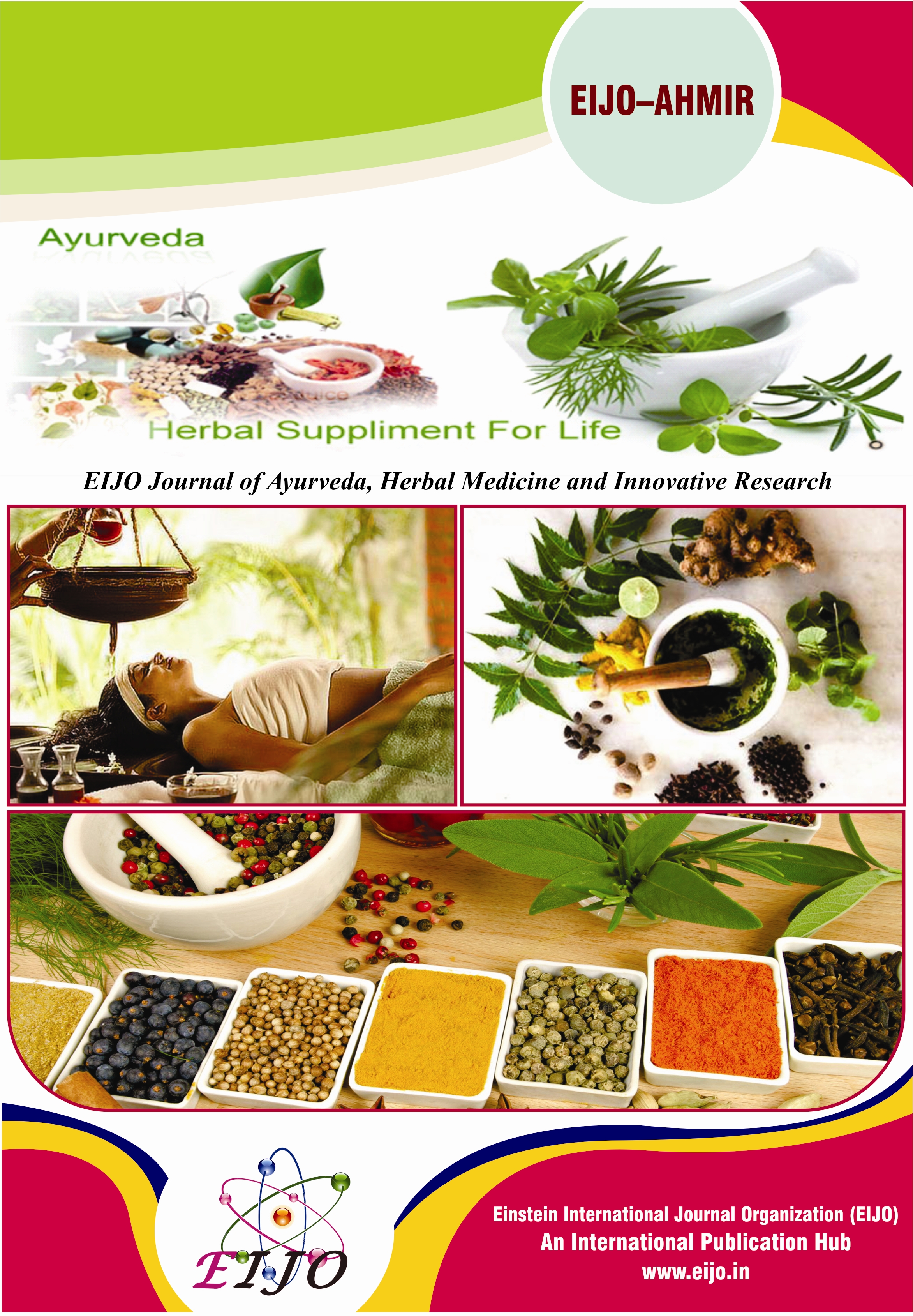JOURNALS || EIJO Journal of Ayurveda, Herbal Medicine and Innovative Research (EIJO – AHMIR) [ ISSN : 2456 - 530X ]
Abstract
The world of flowers can be considered as the most amazing gift offered by Mother Nature. Some of the flowers can be considered as functional foods due to their medicinal and nutritional values. This review was carried out with the objectives of enlisting edible flowers in Sri Lanka, to explore the culinary methods and to explore the nutritional and medicinal values of them. The information was gathered from ayurvedic and traditional texts, open interviews, an old as well as recent recipe books, and from scientific articles. There are about 26 edible flowers currently used by Sri Lankan community. Some of them are recorded as poisonous to animals, but there are specific methods to cook them. Sri Lankans do not eat these flowers in fresh forms like other countries; therefore specific fragrance is not expected, except flowers like clove. As these flowers are not commercially cultivated, they are not contaminated with agrochemicals. Some parts of certain flowers have to be removed before cooking. Ayurveda theories describe their properties as Thridosha Shamaka (pacifying three bio energies) and Dhathu Poshaka (body tissues nourishing) etc. They are also beneficial in treating diseases in gastrointestinal tract, eye disorders, respiratory disorders and urinary disorders according to Ayurvedic teachings. This data can be used to promote the use and medicinal values of edible flowers among the community.
Keywords: Functional Foods, Thridoshashamaka, Dhathuposhaka.
[1]. Agnivesa, CakrapaniDatta’s Ayurveda Dipika, CarakaSamhita, Sutra Sthana, 11/35, english translation by vaidya Sharma R.K and vaidyaBhagwan Dash, 2nd edition, vol. 1, Chowkhamba Sanskrit Series office, Varanasi, 2009,pg 220
[2]. Singh Ram Harsha. Swasthavrattavigyan. 1sted. Varanasi: ChaukhambhaSurbharatiPrakashan; 2003
[3]. Agnivesa, CakrapaniDatta’s Ayurveda Dipika, CarakaSamhita, Sutra Sthana, 27/5-7, english translation by vaidya Sharma R.K and vaidyaBhagwan Dash, 2nd edition, vol. 1, Chowkhamba Sanskrit Series office, Varanasi, 2009,pg 493
[4]. Agnivesa, CakrapaniDatta’s Ayurveda Dipika, CarakaSamhita, Sutra Sthana, 27/3, english translation by vaidya Sharma R.K and vaidyaBhagwan Dash, 2nd edition, vol. 1, Chowkhamba Sanskrit Series office, Varanasi, 2009,pg 490
[5]. Sharma RK, Bhagwan Dash. CharakaSamhita(text with English Dipika). Chaukhambha Sanskrit Series Office. Vol I, Sutra Sthana 1/65 Varanasi:Reprint 2009,pg 46.
[6]. Agnivesa, CakrapaniDatta’s Ayurveda Dipika, CarakaSamhita, Sutra Sthana, 26/40, english translation by vaidya Sharma R.K and vaidyaBhagwan Dash, 2nd edition, vol. 1, Chowkhamba Sanskrit Series office, Varanasi, 2009,pg 463
[7]. Susruta, SusrutaSamhita, Sutra Sthana, 42/13, english translation by GD Singhal,2nd edition, vol. 1,Chaukhamba Sanskrit Pratishthan, Bungalow Rd, Delhi, 2007, pg 348.
[8]. Agnivesa, CakrapaniDatta’s Ayurveda Dipika, CarakaSamhita, Sutra Sthana/5 , english translation by vaidya Sharma R.K and vaidyaBhagwan Dash, 2nd edition, vol. 1, Chowkhamba Sanskrit Series office, Varanasi, 2009,pg 105 – 109
[9]. Agnivesa, CakrapaniDatta’s Ayurveda Dipika, CarakaSamhita, Sutra Sthana/5 , english translation by vaidya Sharma R.K and vaidyaBhagwan Dash, 2nd edition, vol. 1, Chowkhamba Sanskrit Series office, Varanasi, 2009,pg 105 - 109
[10]. Agnivesa, CakrapaniDatta’s Ayurveda Dipika, CarakaSamhita, Sutra Sthana, 27/98- 113, english translation by vaidya Sharma R.K and vaidyaBhagwan Dash, 2nd edition, vol. 1, Chowkhamba Sanskrit Series office, Varanasi, 2009,pg 511.
[11]. Foote JA, Murphy SP, Wilkens LR, Basiotis PP, Carlson A: Dietary variety increases the probability of nutrient adequacy among adults. J Nutr 2004, 134:1779–1785.PubMed.
[12]. Wahlqvist ML, Lo CS, Myers KA: Food variety is associated with less macrovascular disease in those with type II diabetes and their healthy controls. J Am CollNutr 1989, 8:515–523.PubMed.
[13]. Fernandez E, D’Avanzo B, Negri E, Franceschi S, La Vecchia C: Diet diversity and the risk of colorectal cancer in northern Italy. Cancer Epidemiol Biomarkers Prev 1996, 5:433–436.PubMed.
[14]. Lucenteforte E, Garavello W, Bosetti C, Talamini R, Zambon P, Franceschi S, Negri E, La Vecchia C: Diet diversity and the risk of squamous cell esophageal cancer. Int J Cancer 2008, 123:2397–2400.PubMedView Article
[15]. Shekar M, Somanathan A, Lidan D, Atukorala S: Malnutrition in Sri lanka: scale, scope, causes, and potential response. South Asia Region: Human Development Unit; 2007.
[16]. Katulanda P, Jayawardena MA, Sheriff MH, Constantine GR, Matthews DR: Prevalence of overweight and obesity in Sri Lankan adults.Obes Rev 2010,11(11):751–756.PubMedView Article.
[17]. Wijewardene K, Mohideen M, Mendis S, Fernando D, Kulathilaka T, Weerasekara D, Uluwitta P: Prevalence of hypertension, diabetes and obesity: baseline findings of a population based survey in four provinces in Sri Lanka. Ceylon Med J 2005, 50:62.PubMed.
[18]. Ahlbom A, Norell S. Introduction to Modern Epidemiology. Chestnut Hill, USA: Epidemiology Resources Inc; 1990.
[19]. KENNEDY G.L. Four broad concepts fit within the definition of food security, food availability, food access, utilization and sustainability (evaluation of dietary diversity scores for ... - Libraryibrary.wur.nl/WebQuery/edepot/14551.
[20]. http://nutritiondata.self.com/facts/vegetables-and-vegetable-products/2597/2#ixzz41b5aHTBS.
[21]. Sara Ipatanco. Nutritional value of edible flower.
[22]. http://www.livestrong.com/article/385150-nutritional-value-of-edible-flowers/.
[23]. Voon, H.C., Bhat, R. and Rusul, G. (2012) Flower Extracts and Their Essential Oils as Potential Antimicrobial Agents for Food Uses and Pharmaceutical Applications, Comprehensive Reviews in Food Science and Food Safety, 11, pp 34-55.
[24]. TalpatePiliyam, 1993,1- 21, Dep.of Ayurveda, No 325, NM Perera Mw, Colombo 8.
[25]. Medicinal Flowers, GyanendraPandey, 1992, Sri Satguru Publications, Shakti Nagar, Delhi, India
[26]. Abhayagunawardhana, Kali Sanya/Kali Pitapotha,1988, Dissanayake publication, Gampaha
[27]. Rev. Gnanavimala K, Yogarnawaya, 1963, MD Gunasena publishers, Nugegoda.
[28. S Wijesuriya, Traditional foods in Sri Lanka, 1998, Thalawatugoda Rd, Mirihana



